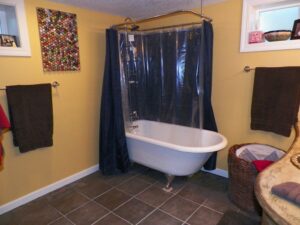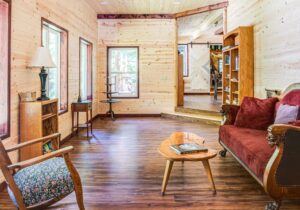A tiled shower room. A rainforest showerhead. A soaking tub you can truly hunker down in. His-and-her sinks. A heated travertine floor. If you’re steaming for a new master bathroom, these are undoubtedly some of the features you’re going to try to squeeze into the space. Oregon Home asked a tilesetter, two designers and an architect for ways to do the room right.
[1. Assess your true need for privacy before you green-light a master bath that has a trendy open floorplan.]
Yeah, we’ve seen spacious master suites with a two-sided fireplace so that a lounging spouse can sneak a romantic peek at his bathing beauty. Before you ban interior walls in your master bath, realize that sometimes you won’t mind someone else being there—and sometimes you will. “Ideally what you want is a space where you can keep the bathing and toilet areas somewhat separate,” says Jack Barnes, the principal at Jack Barnes Architect in Portland. “You can do that by creating a separate compartment for the toilet or arranging the placement so that one is out of sight of the other.”
[2. If you want a spacious bath in your vintage home, prepare to sacrifice space.]
You may love your home and all of its quirks such as sloped ceilings and nooks and crannies, but turn-of-the-century bathrooms often fail to meet 21st century requirements. “Older homes weren’t planned with a master bath—or for adding one where one isn’t,” says Barnes. “The small baths can be a real layout puzzle and sometimes you need to decide what other space in the house you want to sacrifice to make the master bath larger. You may need to forget about having a big walk-in closet to give yourself a spacious, refreshing start to the day.”
Even with a small, older home, you can still come up with a nice design. “I can usually find a great solution, I just have to work harder to get there,” says Barnes. “A smaller space requires me to be more creative, and I often end up with some really neat solutions that ultimately create a livelier space. Sometimes the solution can be as simple as adding a dormer or placing a skylight in just the right place to give the illusion of headroom.”

[3. Design a master bath with the master bedroom in mind.]
Particularly when a master bath opens off a bedroom, it’s important to take an integrated approach to the space. “Design a bit of the bathroom and then look at the space,” says Barnes. “Make your changes and go from there, so it functions how you need it to.”
Plan the spaces so they flow together in a way that fits your lifestyle. “Bed placement is important in terms of privacy and flow,” says Kathy Kremer, a building designer and the owner of K. Kremer Designs in Lake Oswego, Ore. “Think about who gets up first and whether or not the bedroom needs to remain quiet, and come up with a design solution. I once designed a master suite where the bathroom led to a dressing room that you could exit into the hall so you never had to re-enter the bedroom after you showered.”
[4. Install electric mats for a warm floor.]
While radiant heat is a nice feature, if you’re only in your bathroom for short amounts of time, you can install a feature with a timer to give you toasty toes. “There’s another option for radiant heat,” says Barnes. “There are electric mats you can place under the floor that work well with tile and in older homes. You can install a timer so that the bathroom floor will be warm when you wake up in the morning. It can be a lot easier to do that than to retrofit a heating system.”
[5. Don’t make the master bath the largest room in the house.]
Whether your home is old or new or large or small, resist the urge to super-size your master bath. “The scale of the bathroom should fit the scale of your home,” says David Day, a designer and the sales manager at North Pacific Supply in Clackamas, Ore. “You want your bathroom to be spacious and comfortable, but it shouldn’t take over the whole house. It’s important to maintain a sense of proportion.”
[6. Don’t soup up your bath with every amenity known to spa-goers.]
Hitting the plumbing fixture showrooms is a must-do, but work with a designer or an architect to fine-tune your sink, toilet, and showerhead and body spray choices to custom-fit your family. “You should try to pull back from over-the-top items,” says Barnes. “The master bathroom isn’t the place to design to impress others.”
Keep in mind the aesthetic effect of an overabundance of nozzles. “The trend is toward simplicity,” says Kremer. “The shower is one place where you can really go nuts with valves, handhelds and body sprays. The problem with all those is that it ends up looking like you’re going into a carwash that’s made out of marble.”
[7. One word: Ventilation.]
You can have your designer dream up the coolest ceiling-to-vanity-top mirror with a drop-dead-gorgeous chandelier emerging from its center, but if the whole place fogs up when you shower, what’s the point? “Ventilation is key in any bathroom,” says Barnes. “I usually recommend that you have a bath fan at low volume all the time. You can also set a fan on a timer, and some even have a moisture sensor so they will come on automatically as needed.”
[8. Select a tub that reinforces the design statement you want your master bath to make.]
Choose wisely because the first thing people will notice when they walk into your bathroom is that huge soaking tub proudly occupying a big chunk of floor space. Make sure you integrate it into the overall design of your bathroom. “Balancing the proportion of the tub with the rest of the room is important,” says Kremer, who likes to use cast iron tubs. “They look good and you can undermount them. You can build cabinetry around them and flank them with vanities, so the tub visually becomes more a part of the bathroom.”
[9. Before you design your bathroom, think about your bathroom needs.]
“The master bath is the one space in the house that’s designed just for you, so it’s important that you express what you want to your architect,” says Barnes. “I often have to ask my clients a lot of personal questions, but a master bath should be designed for your own pleasure.”
Thinking through how you’ll use your bathroom can save you money because you’ll be less likely to install unnecessary features. “You may like the idea of dual vanities, but if you and your spouse are rarely in the bathroom at the same time, you may not need two sinks,” says Day. “The same is true of a tub. You may like the idea of a tub, but a lot of people rarely use them. In that case, you might be better off with a really nice shower rather than having a tub take up a big chunk of your shower space.”
[10. Use eco-friendly finishes and fixtures.]
While a room devoted to water usage might not seem a likely place to go green, there are many easy-on-the-earth options to choose from. “To be energy-efficient, you can install low-flow showerheads and dual-flush toilets,” says Barnes. “For design elements, go with recycled glass tiles.”
In fact, it’s especially important to pick a master suite’s finishes with care. “A master suite should be very calming,” says Kremer. “Simplify the visuals and be sure to use natural materials. When you’re sleeping, you’re most vulnerable to toxic materials, so pay attention to the finishes and even to how the cabinetry is constructed.”
[11. Leave space for space.]
While most of the pieces in a bathroom are attached to a wall, remember to make room for you to move around and for stand-alone furniture. “Leaving space for a piece of furniture like a chair can really turn a bathroom into a special place,” says Barnes. “Maybe you want a chair where you can brush your hair or clip your nails. Dedicate space for things you plan on adding to the room and also dedicate enough space for you to move around comfortably without the room feeling cramped.”
[12. Budget for plumbing.]
You may have done a line-item budget for all the new showerheads and jet sprays in your new spa bathroom, but if you haven’t budgeted for additional plumbing, you’ll be left high and dry. “You really need to budget for all the water that will come out of your new fixtures,” says Day. “You can’t drain a toilet through the middle of the kitchen below the master bath. You might find that you’re going to have rearrange the pipes and cut into a room downstairs to make everything fit. A lot of times people don’t realize how much needs to be done.”
The same is true of the water heater. “If you plan on having a soaking tub, you need to plan for the necessary hot water capacity,” says Day. “You can always install a smaller water heater upstairs, but you’ll need to plan for that space.”
[13. Before you select your plumbing fixtures, plan for storage.]
Storage is a key element in a bathroom, so make sure you’ll have enough space for all the things you’ll need before you spring for the oversized sink. In fact, storage should be one of the first things you discuss with your designer. “I spend a lot of time talking about storage,” says Barnes. “Ask yourself what kind of things you need places for. In the area around the bathtub, you can add niches and storage spaces that can make a bathroom look interesting. If you have a must-have item, create a place for it. I once designed a cupboard where a hair dryer that was always plugged in could hang. You can’t relax when you have clutter around you, and if you don’t plan the space properly it’s almost impossible to move fixtures around after they’ve been installed.”
[14. Don’t buy a few tiles of every tile pattern that strikes your fancy.]
With all the designer tile, it’s easy to go overboard. Realize that you can do a lot without bringing home the It tile. “Travertine is nice in a shower, and you can lay it in a lot of ways,” says tilesetter Matthew Kennedy, the owner of Kennedy Tile in Beaverton, Ore. “I like to put it halfway up the shower and then do a strip that juts out like crown molding. Above that, I cut the travertine and set it on the diagonal. Even with a traditional subway surround and a hex tile floor, you can do a lot with accent tiles.”
[15. Don’t make the tile in the shower wildly different from tile elsewhere in the room.]
While the tile patterns don’t have to be exactly the same, come up with tile work that complements each other. “It’s nice to tie together all of the tile in a room,” says Kennedy. “I did a shower where I put in some glass liner tile, and I also used it in the backsplash. Think about using accent tiles as a way to tie the bathroom together.”
If you think creatively, you can come up with unconventional ways to use tile in a bathroom. “One of the most unusual projects I worked on was a shower floor where I’d set natural pebbles,” says Kennedy. “The pebbles flowed over the shower curb and then came through the tile in the floor in the shape of a path.”
[16. Choose finishes that can take the moisture.]
In designing a bathroom, select products that can stand daily exposure to water. “Don’t try to save money by using a tile in the shower that’s made to be a floor tile,” says Kennedy. “Sometimes those glazes aren’t very strong, so they won’t perform well in a shower.”
The same holds true for the cabinetry. When wood meets water, warping isn’t far behind. “Pay attention to the inner workings of the vanity cabinet,” says Day. “Make sure the cabinet is made of sturdy materials. If you don’t have good ventilation, moisture will effect the cabinetry and it will start to look bad or it might even delaminate. And always avoid putting cabinetry too close to the tub or shower.”
[17. Make sure your shower room doesn’t shower the rest of the bathroom.]
“I like doorless shower areas,” says Day. “You can install two showerheads so more than one person can use it at time, but you need to design it so water doesn’t shoot into the rest of the room. The minimum for a doorless shower is a 6-by-6-foot space, but if you can go to 6 by 8 feet, that’s even better.”







